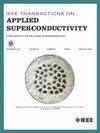Numerical Simulations in Stand-Alone REBCO Coils Under Rotating Magnetic Fields
IF 1.8
3区 物理与天体物理
Q3 ENGINEERING, ELECTRICAL & ELECTRONIC
引用次数: 0
Abstract
Large ac loss in the high-temperature superconducting (HTS) armature windings carrying ac under a rotating magnetic field poses a significant challenge for high power-to-weight ratio all-HTS rotating machines. Understanding the loss behavior of HTS coils in rotating magnetic fields and exploring methods for loss reduction are essential. This study numerically investigates the total ac loss (旋转磁场下独立REBCO线圈的数值模拟
高温超导(high- superconducting, HTS)电枢绕组在旋转磁场下携带交流的大交流损耗对高功率重量比的全高温超导旋转电机提出了重大挑战。了解高温超导线圈在旋转磁场中的损耗行为,探索降低损耗的方法是至关重要的。本文对非均匀旋转磁场下高温超导线圈的总交流损耗(Qtot)(有电流)和磁化损耗(Qm)(无电流)进行了数值研究。比较了3种4匝高温超导线圈的损耗,分别采用4 mm宽的带、2 mm细丝的条纹带和4 mm细丝的条纹带设计。此外,计算和评估了77 K和65 K时线圈中的交流损耗。仿真结果表明,在旋转磁场作用下,线圈的条纹结构显著降低了Qtot和Qm。在高磁场下(例如,在77 K下,超过200 mT的Qm),与无条纹线圈的损耗相比,用两丝条纹带设计的线圈的损耗减少了近一半,用四丝条纹带设计的线圈的损耗减少了近四分之一。有趣的是,我们还表明,在旋转磁场下,Qm和Qtot可以有效地与线圈或磁带的临界电流进行缩放。这表明在不同温度下的损耗可以用各自的临界电流来估计。
本文章由计算机程序翻译,如有差异,请以英文原文为准。
求助全文
约1分钟内获得全文
求助全文
来源期刊

IEEE Transactions on Applied Superconductivity
工程技术-工程:电子与电气
CiteScore
3.50
自引率
33.30%
发文量
650
审稿时长
2.3 months
期刊介绍:
IEEE Transactions on Applied Superconductivity (TAS) contains articles on the applications of superconductivity and other relevant technology. Electronic applications include analog and digital circuits employing thin films and active devices such as Josephson junctions. Large scale applications include magnets for power applications such as motors and generators, for magnetic resonance, for accelerators, and cable applications such as power transmission.
 求助内容:
求助内容: 应助结果提醒方式:
应助结果提醒方式:


